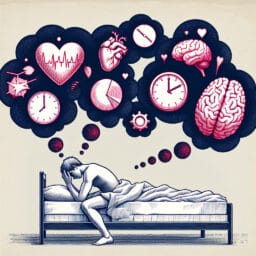Understanding Rapid Sleep Onset: Definition and Implications
Table of Contents
- Introduction
- Understanding the Sleep Cycle
- Causes of Rapid Sleep Onset
- Implications of Rapid Sleep Onset
- Managing Rapid Sleep Onset
- Conclusion
- Frequently Asked Questions
Introduction
An interesting aspect of the sleep cycle is Rapid Sleep Onset (RSO) – a phenomenon characterized by an unusually swift transition from wakefulness to entering REM sleep. While most individuals take about 90 minutes to reach the REM stage post falling asleep, those experiencing RSO often do so in under 15 minutes. This accelerated sleep latency, akin to an expedited journey through NREM sleep stages, can be indicative of certain sleep disorders like narcolepsy or idiopathic hypersomnia. Decoding RSO’s prominence in a person’s sleep pattern is integral for healthcare providers and can be done via a meticulous examination of their multiple sleep latency test results or through insights from a comprehensive sleep study report.
Understanding RSO carries immense importance in the field of sleep medicine as it serves as an essential component in diagnosing unusual sleeping behaviors. It aids professionals in distinguishing between different types of excessive sleepiness conditions such as narcolepsy people struggle with and idiopathic hypersomnia. Moreover, analyzing data on total recording time alongside rapid eye movement durations helps infer overall sleep efficiency and quality – highlighting any discrepancies that might exist due to unwarranted fluctuations in REM and non-REM stages. Consequently, this enables personalization of treatment methods like cognitive behavioral therapy or medication adjustments based on individual needs resulting from findings like longer or shorter than normal onset latencies.
Understanding the Sleep Cycle
The winding down of daily activities and the onset of drowsiness signals the start of a complex journey our bodies embark on every night – the sleep cycle. This voyage begins with light, non-rapid eye movement (NREM) sleep and progresses to deep NREM sleep, during which our body repairs muscles, strengthens the immune system, and consolidates memories. The final destination is Rapid Eye Movement (REM) sleep – an intense stage where most dreaming occurs. Normally, it takes approximately 90 minutes from falling asleep to entering REM sleep – a measure known as sleep latency that is critical in evaluating sleep quality.
In contrast to this typical pattern, Rapid Sleep Onset (RSO) presents an intriguing deviation. RSO individuals have shorter sleep latencies as they make an abrupt leap into REM stage within less than 15 minutes of falling asleep. This swift transition bypasses essential stages of NREM slumber that contribute to restorative functions integral for physical health and cognitive performance.
The implications are significant: RSO could be a symptom signaling undiagnosed problems such as a chronic lack of adequate total sleep time, or ‘sleep debt’, leading to excessive daytime drowsiness and compromised productivity. It could also be indicative of more serious conditions like narcolepsy or idiopathic hypersomnia – both marked by excessive daytime fatigue irrespective of sufficient night-time rest.
Multiple Sleep Latency Test measuring rapid-onset REM occurrences can help healthcare providers identify these disorders early on; they can then devise personalized interventions focusing on good ‘sleep hygiene’ practices or adjustment with cognitive behavioral therapy based on individual needs.
Thus understanding RSO isn’t merely about comprehending another nuance in one’s sleeping pattern but has much broader implications for overall wellbeing too! By maintaining healthy daily habits such as consistent bedtimes alongside keeping track of changes via tools like a ‘sleep diary’, we can ensure optimal quality slumber resulting in enhanced day-to-day functioning encompassing physical health and cognitive clarity. Remember, a good night’s sleep isn’t just about total hours slept – it’s about the journey through each sleep stage that matters too!
| Term | Description | Implication |
|---|---|---|
| Non-Rapid Eye Movement (NREM) Sleep | This is the initial stage of sleep, which begins with light sleep and progresses to deep sleep. During this stage, the body repairs muscles, strengthens the immune system, and consolidates memories. | It’s an essential stage of sleep for restorative functions, physical health, and cognitive performance. |
| Rapid Eye Movement (REM) Sleep | This is the final and intense stage of sleep where most dreaming occurs. The transition from falling asleep to REM sleep typically takes approximately 90 minutes. | A critical measure of sleep quality known as sleep latency. |
| Rapid Sleep Onset (RSO) | RSO individuals enter the REM stage within less than 15 minutes of falling asleep, bypassing the essential NREM stages. | RSO could signal undiagnosed problems like chronic sleep debt, narcolepsy, or idiopathic hypersomnia, leading to excessive daytime drowsiness and compromised productivity. |
| Multiple Sleep Latency Test | This test measures rapid-onset REM occurrences | It can help healthcare providers identify sleep disorders early on, allowing for personalized interventions based on individual needs. |
| Sleep Hygiene Practices | These are healthy sleep habits, such as maintaining consistent bedtimes and tracking changes with tools like a ‘sleep diary’. | Good sleep hygiene can ensure optimal quality sleep, resulting in enhanced physical health and cognitive clarity. |
Causes of Rapid Sleep Onset
The intricacies of Rapid Sleep Onset (RSO) can be traced back to a medley of factors, spanning from genetic predispositions to lifestyle habits and underlying medical conditions. RSO could have its roots in your DNA; studies conducted in sleep laboratories suggest that certain gene variants may influence sleep onset latency, thereby serving as the main symptom for this sleeping anomaly. Furthermore, an individual’s daily habits can significantly impact sleep stages and total sleep time. For instance, irregular bedtimes fueled by modern life demands or excessive screen time can disrupt our internal medicine – the body’s natural circadian rhythm. This disruption often accelerates the transition into REM stage, causing potential sleep deprivation.
Medical conditions such as narcolepsy or idiopathic hypersomnia are also closely linked with RSO. These disorders are primarily characterized by excessive daytime drowsiness due to disrupted NREM sleep stages and shorter than normal sleep latency periods. Diagnosing these disorders often entails comprehensive evaluations including multiple sleep latency testing methods administered by healthcare providers or trained specialists in a controlled environment like a ‘sleep study’. While deciphering personal experiences with falling asleep might seem daunting at first glance, understanding this complex phenomenon is vital in maintaining good ‘sleep hygiene’ and overall health!
A combination of accurate diagnosis through tools like Multiple Sleep Latency Tests, tailored interventions such as cognitive behavioral therapy or regulation of daily habits could prove instrumental in managing RSO effectively – ultimately enhancing both one’s quality of slumber and daytime productivity! So while we cannot control our genetic makeup influencing how rapidly we enter REM sleep post falling asleep, becoming aware about key contributing factors provides us with valuable insights that may help mitigate its impact on our lives.
| Factors Contributing to Rapid Sleep Onset (RSO) | Description |
|---|---|
| Genetic predisposition | Studies in sleep laboratories suggest that certain gene variants may influence sleep onset latency, a primary symptom of RSO. |
| Lifestyle habits | Irregular bedtimes, excessive screen time, and other modern lifestyle habits can disrupt the body’s natural circadian rhythm, accelerating the transition into REM stage and potentially causing sleep deprivation. |
| Underlying medical conditions | Conditions such as narcolepsy or idiopathic hypersomnia, characterized by excessive daytime drowsiness due to disrupted NREM sleep stages and shorter sleep latency, are closely linked with RSO. |
| Accurate diagnosis | Tools like Multiple Sleep Latency Tests, often administered by healthcare providers in a controlled environment, can help diagnose RSO. |
| Tailored interventions | Interventions, such as cognitive behavioral therapy or regulation of daily habits, could help manage RSO effectively, enhancing sleep quality and daytime productivity. |
Implications of Rapid Sleep Onset
The implications of Rapid Sleep Onset (RSO) extend beyond the realm of physical health and delve into the psychological and social aspects as well. From a health perspective, RSO can be an indicator of sleep disorders like narcolepsy or idiopathic hypersomnia – conditions marked by excessive daytime fatigue regardless of sufficient night-time rest, which can lead to a compromised immune system and cognitive performance. Psychologically speaking, individuals with a faster sleep latency may find themselves grappling with heightened anxiety levels due to concerns about their abnormal sleep behavior. The constant tug-of-war between wanting to stay awake and the inexorable pull towards REM stage within moments of falling asleep can create mental distress.
Moreover, studies conducted in sleep laboratories suggest that such swift transitions into REM stage often lead to fragmented night-time rest; this could potentially affect total recording time during Multiple Sleep Latency Tests – thereby impacting the accuracy in diagnosing any underlying abnormalities. From a societal perspective, excessive daytime drowsiness resulting from RSO could contribute towards decreased productivity at work or school – creating hurdles in maintaining consistent daily routines that align with societal norms. Hence it becomes imperative for healthcare providers using tools like comprehensive sleep study reports to recognize these signs early on so they can devise personalized interventions focusing on good ‘sleep hygiene’ practices or adjustment with cognitive behavioral therapy based on individual needs. Such steps would not only yield better control over one’s rapid transition into REM sleep but also boost overall quality of life.
Managing Rapid Sleep Onset
A major stride in the realm of sleep medicine, managing Rapid Sleep Onset (RSO) is a multifaceted process that demands an amalgamation of medical interventions, lifestyle changes, and psychological support. Medical professionals often leverage multiple sleep latency tests to measure sleep latency and diagnose sleep disorders such as idiopathic hypersomnia or narcolepsy. Once diagnosed, cognitive behavioral therapy can be instrumental in reducing excessive sleepiness by modifying thought patterns around sleeping habits. Simultaneously, enforcing beneficial daily habits such as maintaining consistent bedtimes and keeping a ‘sleep diary’ can help regulate the internal circadian rhythm mitigating rapid transitions to REM stage from wakefulness. Furthermore, psychological counselling plays a pivotal role in helping individuals stay awake longer by addressing concerns related to abnormal sleeping behaviors and easing any anxiety caused by RSO. Hence, navigating through this complex condition requires not only expertise from healthcare providers but also active participation from individuals for effective management of their unusual journey across various stages of the sleep cycle.
Conclusion
Rapid Sleep Onset (RSO), characterized by a swift transition from wakefulness to the REM stage, is a compelling anomaly in the realm of sleep medicine. It signifies an expedited journey through the different sleep stages, often bypassing critical NREM sleep that is essential for memory consolidation and muscle repair. This abrupt shift not only impacts total sleep time but also poses potential risks like excessive daytime drowsiness, commonly associated with idiopathic hypersomnia or narcolepsy people struggle with. Observing such abnormalities during multiple sleep latency tests can provide healthcare providers crucial insights into diagnosing underlying sleep disorders effectively. Moreover, total recording time data during these tests aids in assessing overall sleep efficiency, thereby allowing for personalized interventions such as cognitive behavioral therapy based on specific needs. Consequently, it becomes paramount to pay heed to unusual sleeping behaviors like RSO and seek guidance from trained specialists in internal medicine or those conducting comprehensive sleep study reports in established laboratories for effective management of your slumber health. Recognizing these unique nuances within your sleep cycle goes beyond just understanding your daily habits; it could be instrumental in ensuring optimal cognitive performance and achieving superior quality of life.


